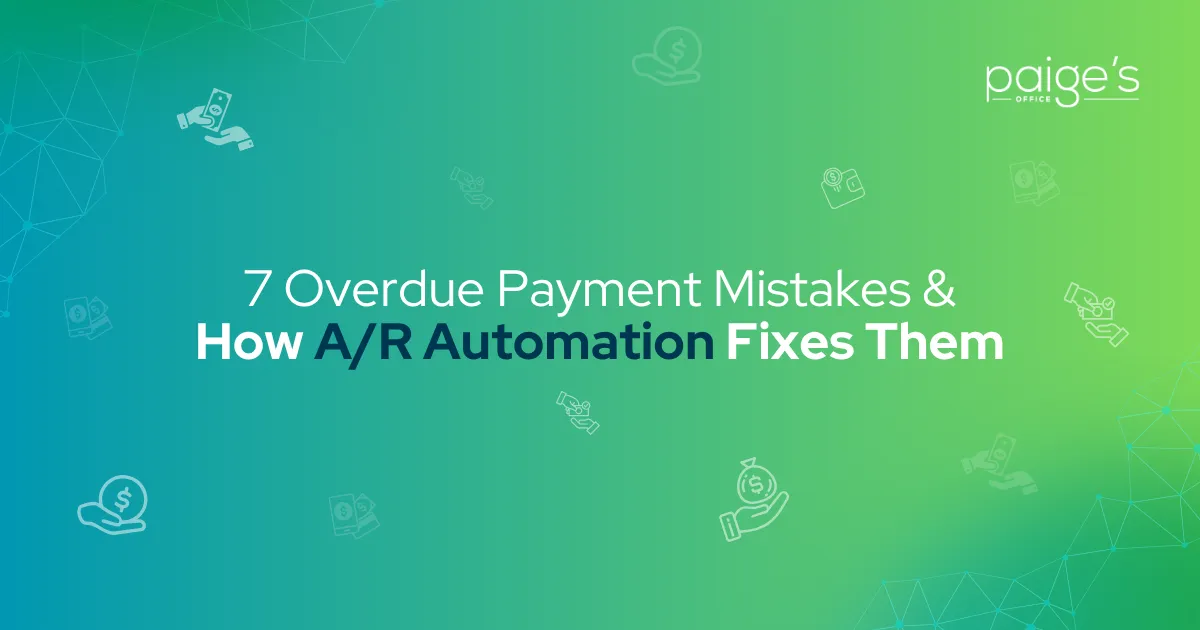
7 Overdue Payment Mistakes & How A/R Automation Fixes Them
Late payments are more than just a minor inconvenience—they disrupt cash flow, delay growth, and create unnecessary stress for business owners. In fact, a recent April 2025 survey by The Kaplan Group revealed that 82% of companies face moderate to critical cash flow issues due to overdue payments, and over 11% lose more than 5% of their annual revenue—a number that jumps to 22% for fast-growing SaaS businesses.
While most businesses recognize the importance of getting paid on time, many unknowingly make small mistakes that snowball into bigger financial issues. From delayed invoicing to inconsistent follow-ups, these missteps can silently hurt your revenue cycle.
In this blog, we’ll walk you through the top 7 mistakes businesses make when handling overdue payments—and more importantly, how you can avoid them.
Let’s get started!
Mistake #1: Delaying Invoice Issuance

One of the most common yet costly mistakes businesses make is waiting too long to send invoices. The longer you delay, the less urgent the payment feels to your client, and the more likely it is to be forgotten or deprioritized.
Timely invoicing sets the tone for prompt payment and shows your business runs on discipline, not delays.
According to a study by Fundbox, small businesses in the U.S. are owed over $900 billion in unpaid invoices, largely due to inconsistent billing practices.
Sending invoices immediately after project completion or service delivery gives you a head start in the collection process and strengthens your cash flow cycle.
How does it affect your business?
Cash Flow Disruption: Late invoicing delays incoming funds, creating unnecessary liquidity issues.
Vendor Delays: Due to slower collections, you may struggle to pay suppliers or partners on time.
Missed Payments: The longer you wait, the higher the chance of invoices being forgotten or overlooked.
Mistake #2: Sending Incomplete or Error-Prone Invoices

Even small errors like wrong invoice numbers, incorrect amounts, or missing payment terms can lead to major delays. Clients won’t prioritize payments they have to investigate or dispute.
Accuracy in invoicing reflects your business’s reliability and reduces back-and-forth. The fewer the errors, the faster the payments.
A survey by PYMNTS found that invoicing errors and inconsistencies cause 60% of payment delays.
How does it affect your business?
Payment Delays: Clients pause payment until the invoice is corrected.
Client Frustration: Mistakes create friction and erode trust over time.
Administrative Waste: You spend extra time correcting and resending invoices.
Mistake #3: Vague or Hidden Payment Terms

Unclear or buried payment terms confuse clients and lead to disputes or delays. If expectations aren’t clearly set up front, you can't expect timely payments.
Terms should be visible, concise, and written in plain language. Be transparent about due dates, late fees, and payment methods.
Clarity creates accountability—vagueness creates excuses.
How does it affect your business?
Client Confusion: Ambiguous terms increase back-and-forth and delay decisions.
Reduced Accountability: Clients can claim ignorance or misinterpret your terms.
Inconsistent Cash Flow: Unpredictable payment behavior makes forecasting difficult.
Mistake #4: Neglecting Consistent Follow-Up

Following up just once isn’t a strategy—it’s a shot in the dark. Inconsistent reminders tell clients you’re not serious about getting paid.
A structured follow-up schedule—via email, SMS, or calls—shows professionalism and urgency. Use automation tools to stay consistent.
Research shows automated follow-ups can speed up payments by up to 25%.
How does it affect your business?
Unpaid Invoices: Invoices get buried or forgotten without timely nudges.
Lost Time: Chasing overdue payments manually drains your team’s resources.
Revenue Uncertainty: You can’t plan finances around unpaid invoices.
Mistake #5: Letting Receivables Age Without Action

The older a receivable gets, the harder it is to collect. Many businesses wait too long to escalate, hoping the client will pay “eventually.”
Instead, aging reports should guide next steps—emails, calls, or escalation to recovery partners. Time is leverage in collections.
Studies show most unpaid invoices become uncollectible after 90 days.
How it affects your business:
Bad Debts: Old receivables may eventually need to be written off.
Cash Gaps: Delayed revenue leads to missed growth opportunities.
Stress on Teams: Finance teams spend more energy on chasing than planning.
Mistake #6: Using Empty Threats or Aggressive Tactics

Threatening legal action too early—or without intent—can damage your credibility. So can overly harsh language that alienates clients.
Assertiveness is key, but professionalism matters more. Escalate strategically, not emotionally. Clients respond better to firmness than fury.
Your tone in collections can preserve or destroy long-term business relationships.
How does it affect your business?
Burned Bridges: Clients may refuse to work with you again.
Reputation Risk: Aggressive tactics can lead to public complaints or reviews.
Wasted Effort: Empty threats lose their power when used carelessly.
Mistake #7: Overlooking Client Experience & Support

If clients can’t easily reach you or feel dismissed when they do, they’ll deprioritize your payments. Collections aren't just about reminders—they're about relationship management.
Offering helpful, human, and accessible support speeds up resolution and payment. Make it easy to pay—and even easier to ask questions.
Don’t just demand payment—make it feel like the right thing to do.
How does it affect your business?
Delayed Responses: Clients hold off on payment while waiting for support.
Negative Sentiment: Poor support impacts future cooperation and referrals.
Lost Loyalty: Clients are more likely to switch to a competitor.
How AR Automation Can Help

It’s a lot to stay on top of, especially when you’re juggling everything else in the business.
That’s why having the right tools in place can make things smoother, faster, and a whole lot easier.
Now, let’s discuss the role that Automation plays in AR:
Instant Invoicing: Invoices are automatically generated and sent the moment a project milestone is completed, a service is delivered, or an order is fulfilled. This eliminates the need for manual input or reminders, ensuring your clients receive their invoices on time, without delay.
Built-in Accuracy Checks: Automated systems sync directly with your CRM or accounting tools, pulling exact figures, service dates, client details, and line items, reducing the risk of human error. These tools run built-in validation checks, flag inconsistencies, and ensure all required information is present before sending an invoice.
Customizable Payment Terms: Whether your business runs on net-15, net-30, or milestone-based billing, automation lets you define and apply consistent payment terms across all invoices. You can highlight due dates, add automatic late fees, and include early-payment discounts—all displayed and easy for clients to understand.
Automated Follow-Ups: Once an invoice is sent, the system takes over—sending gentle reminders before the due date, polite nudges when a payment is late, and progressively firmer communications if the delay continues. These reminders are fully customizable in tone, timing, and frequency and can go out via email, SMS, or even phone calls.
Polished Communication Flows: Instead of reactive, emotionally charged follow-ups, A/R automation platforms use pre-approved templates designed to strike the right tone—professional, polite, and persuasive. As the situation escalates, so does the message intensity, but it always maintains brand integrity and courtesy. This is crucial in protecting long-term client relationships while still reinforcing that payment obligations are taken seriously.
Time & Cost Savings: Manual invoicing and collections can eat up hours of your team’s time each week—time spent tracking down clients, updating spreadsheets, crafting emails, or making calls. With automation, all these repetitive tasks are handled seamlessly in the background. Your team can redirect its energy toward value-adding work like strategic planning, customer service, or growth initiatives.
Better Cash Flow Forecasting: A/R automation gives you real-time visibility into which invoices are due, which are overdue, and which payments are expected soon. Aging reports, payment histories, and client behavior insights are all at your fingertips, helping you make informed financial decisions quickly.
Time to Make AR Easier
Handling overdue payments doesn’t have to be a constant struggle. With the right system in place, invoicing, reminders, and follow-ups can run quietly in the background—giving you more time to focus on your clients, your team, and your growth.
That’s exactly what we are here for.
From sending accurate invoices to streamlining collections, Paige’s Office helps you stay organized, reduce delays, and improve your cash flow without the daily stress.
So if you’re ready to stop chasing payments and start collecting with ease, this might be the tool your business has been waiting for.

